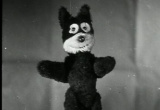Postwar Avant-Garde
Shortly after the Second World War, most of the Filmliga films were stored in the archives of Dutch historical film archive, the forerunner of the Filmmuseum. The first notable screening of these films was in 1949 during EXPRMNTL, which was the first festival for experimental film, held in Knokke. Although recent American films were also shown there, it was still the pre-war avant-garde films that defined the image.
The classical avant-garde lingers
In the years that followed, the classical avant-garde continued to dominate the experimental film programmes, and they remained the benchmark for new work. In the Netherlands, Bert Haanstra (Spiegel van Nederland), Emiel van Moerkerken (Koekoekswals), and the American filmmaker, Hy Hirsch (Gyromorphosis and Autumn Spectrum) still relied heavily on the pre-war avant-garde. But their films lacked the rigorous urgency of their predecessors; they were mainly playful, creative exercises.
1958: a watershed year
It was not until 1958, during the second festival of experimental film in Brussels, that a new wind began to blow. American experimental film was on the rise, and modern European experimental film (whose main representative was Peter Kubelka, with Mosaic im Vertrauen and Adebar) was also claiming its own place.
The Americans are coming
This trend continued into the 1960s, and within a few years, American experimental films (by Kenneth Anger, Maya Deren, Gregory Markopoulos, Stan Brakhage, Jack Smith, Andy Warhol, and the brothers John and James Whitney) were dominating the exhibition circuit.
more information
If you are looking for more material from our collection, please contact Film Sales:
sales@eyefilm.nl
phone +31 (0)20 5891 426


